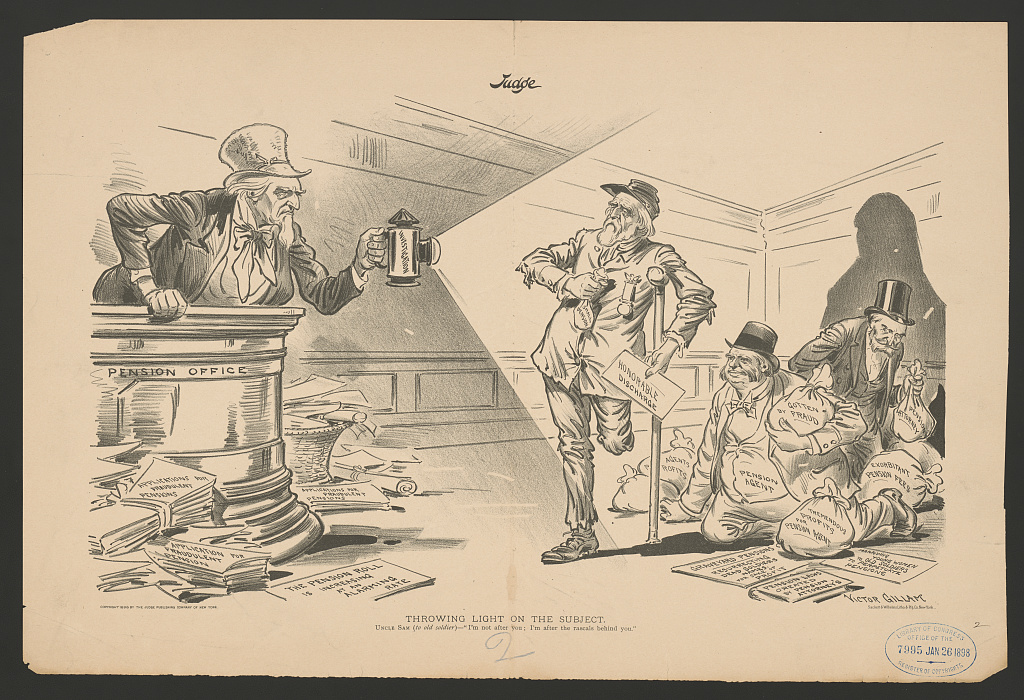
The pension system expanded enormously after the Civil War. The number of Union Veterans, widows, and dependents drawing a pension from the federal government rose from 15,000 in 1863 to over 200,000 in 1871. After stabilizing for a few years, the numbers skyrocketed again in the 1880s and 1890s. By 1893, more than 900,000 persons were on the pension rolls. Two new pieces of legislation spurred the explosive growth towards the end of the century. The Arrears Act of 1879 made pensions retroactive to the date of discharge from service (or death in the case of survivors) rather than the date an application was submitted. Under this law, existing beneficiaries and new claimants were entitled to a lump sum payment of all the money owed to them from previous years. A little over a decade later, Congress passed the Dependent Pension Act of 1890, which granted a pension to any Union Veteran with a disability, regardless of whether it was service related, provided he had served at least 90 days. As a result of these two laws, pensions became the largest item in the federal budget, with annual expenditures exceeding $100 million.
The soaring size and costs of the pension system raised concerns about the prevalence of fraud. In his 1879 annual report to Congress, Pension Commissioner John A. Bentley acknowledged that “the present system is an open door to the Treasury for the perpetration of fraud.” Pension officials lamented that they had no way of evaluating the veracity of the medical exams conducted by local doctors or the affidavits submitted by friends and family members in support of the Veterans’ claims. Physicians, by law, could charge only $1 per exam and they were suspected of slanting their reports in the Veterans’ favor to ensure a steady supply of patients and to remain in the good graces of the communities where they practiced. An equally if not more serious problem was the unscrupulous behavior of pension attorneys, who overcharged Veterans for their services or encouraged persons to file questionable claims to generate more business. The 1879 Arrears Act added another incentive for fraud, as the initial payout to a Veteran or widow averaged $900 or higher, which was more than twice the annual earnings for many workers in the period.
The Pension Bureau tried to combat fraud by urging Congress to reform the system. In 1882, Congress at last adopted a measure long recommended by pension officials. The new law authorized the pension commissioner to appoint standing three-person medical boards at different locations in every state to perform physical exams for pensions. The examination fee received by each member of the board was increased to $2 in the hopes of attracting doctors with higher professional standards. The bureau also used its own clerks to investigate false or inflated pension claims, although the agency was struggling to keep up with the backlog of applications and had little manpower to spare. In the 1870s, the bureau formed a Special Services Division that was dedicated to rooting out fraud in the system. Between 1876 and 1879, the division’s special examiners investigated 5,131 suspicious claims and uncovered fraud in 1,425 of the cases. The spurious claims were removed from the pension rolls, saving the government $1.5 million, Examiners exposed one particularly egregious example of wrongdoing in 1878. A man in Maine had collected close to $20,000 in pension payments on behalf of seven fictitious widows whose claims he had filed.

In 1882, the Pension Bureau replaced the Special Services Division with the Special Examination Division. Besides changing the name of the division, the bureau also changed the way it operated. Instead of working out of the home office in Washington, D.C., and traveling as required to the site of their investigations, special examiners were stationed around the country and assigned specific geographic regions. Congress also heeded the agency’s appeals for more manpower, quadrupling the size of its work force between 1872 and 1882 and allowing the bureau to hire more special examiners. By 1897, there was 342 special examiners in the field. That year, they collected over 200,000 depositions and filed more than 40,000 reports on case. Besides reducing the incidence of pension fraud, their efforts also led to dozens of arrests, indictments, and convictions for criminal offenses ranging from impersonating a government officer to perjury and forgery.
Fraud and corruption in the pension system became less of an issue in the early twentieth century as the number of pensioners declined and new claims slowed to a more manageable rate. The Special Examiner Division dwindled in size to about 50 agents by 1916 but they remained on the job until the very end when the Pension Bureau merged with two other federal agencies to form the Veterans Administration in 1930.
By Alexandra Boelhouwer, Virtual Student Federal Service Intern, Veterans Benefits Administration, and Jeffrey Seiken, Ph.D., Historian, Veterans Benefits Administration
Share this story
Related Stories

History of VA in 100 Objects
Object 96: Postcard of Veterans Vocational School
In 1918, the government created the first nationwide vocational training system to help disabled Veterans acquire new occupational skills and find meaningful work. Over the next 10 years, more than 100,000 Veterans completed training programs in every field from agriculture and manufacturing to business and photography.

History of VA in 100 Objects
Object 95: 1840 Census of Pensioners
In a first, the 1840 census collected data on Veterans and widows receiving a pension from the federal government. The government published its findings in a stand-alone volume titled “A Census of Pensioners for Revolutionary or Military Services.”

History of VA in 100 Objects
Object 94: Southern Branch of the National Home
The Southern Branch of the National Home for Disabled Volunteer Soldiers opened in Hampton, Virginia, in late 1870. The circumstances surrounding the purchase of the property, however, prompted an investigation into the first president of the National Home’s Board of Managers, Benjamin Butler.


